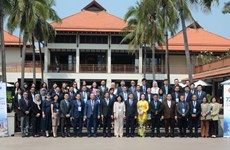ASEAN discusses ways to narrow development gap
The Association of Southeast Asian Nations (ASEAN) and the Organisation
for Economic Cooperation and Development (OECD) recently held a workshop
to seek ways to narrow the development gap among ASEAN members.
The Association of Southeast Asian Nations (ASEAN) and the Organisation
for Economic Cooperation and Development (OECD) recently held a workshop
to seek ways to narrow the development gap among ASEAN members.
At the meeting held at the ASEAN Secretariat headquarters, speakers from the OECD Development Centre, ASEAN Secretariat, and the Economic Research Institute for ASEAN and East Asia exchanged opinions on issues presented in the paper called “OECD Southeast Asian Outlook 2013: Narrowing the Development Gap.”
According to the Narrowing the Development Gap Indicators (NDGIs) recently created by the OECD Development Centre and the ASEAN Secretariat, on an index scale of 0 to 10 - where 0 denotes no gap and 10 the widest gap - the gap between Cambodia, Laos, Myanmar and Vietnam (CLMV), and ASEAN-6 (the remaining countries), is widest on the poverty and human resource development indicators, at 4.4 and 4.0 respectively.
Other gaps are in infrastructure (3.5), trade and investment (3.1), ICT (2.9), and tourism (1.5).
The journey to build an ASEAN Community by 2015 requires countries, including the newer members, to not only stay on the same track but to keep pace, said the speakers, stressing that narrowing the Development Gap is essential to the ASEAN integration process.
Disparities need to be examined beyond differences in income levels to poverty and human capital development, said Kensuke Tanaka, Head of Asia Desk at OECD Development Centre.
Implementing structural policies necessary for enhancing productivity is equally critical to the success of CLMV countries and ASEAN as a whole, contended Dr. Sothea Oum of the Economic Research Institute for ASEAN and East Asia .
Higher investment in social infrastructure, especially in education and health is of particular importance, the official noted.-VNA
At the meeting held at the ASEAN Secretariat headquarters, speakers from the OECD Development Centre, ASEAN Secretariat, and the Economic Research Institute for ASEAN and East Asia exchanged opinions on issues presented in the paper called “OECD Southeast Asian Outlook 2013: Narrowing the Development Gap.”
According to the Narrowing the Development Gap Indicators (NDGIs) recently created by the OECD Development Centre and the ASEAN Secretariat, on an index scale of 0 to 10 - where 0 denotes no gap and 10 the widest gap - the gap between Cambodia, Laos, Myanmar and Vietnam (CLMV), and ASEAN-6 (the remaining countries), is widest on the poverty and human resource development indicators, at 4.4 and 4.0 respectively.
Other gaps are in infrastructure (3.5), trade and investment (3.1), ICT (2.9), and tourism (1.5).
The journey to build an ASEAN Community by 2015 requires countries, including the newer members, to not only stay on the same track but to keep pace, said the speakers, stressing that narrowing the Development Gap is essential to the ASEAN integration process.
Disparities need to be examined beyond differences in income levels to poverty and human capital development, said Kensuke Tanaka, Head of Asia Desk at OECD Development Centre.
Implementing structural policies necessary for enhancing productivity is equally critical to the success of CLMV countries and ASEAN as a whole, contended Dr. Sothea Oum of the Economic Research Institute for ASEAN and East Asia .
Higher investment in social infrastructure, especially in education and health is of particular importance, the official noted.-VNA













